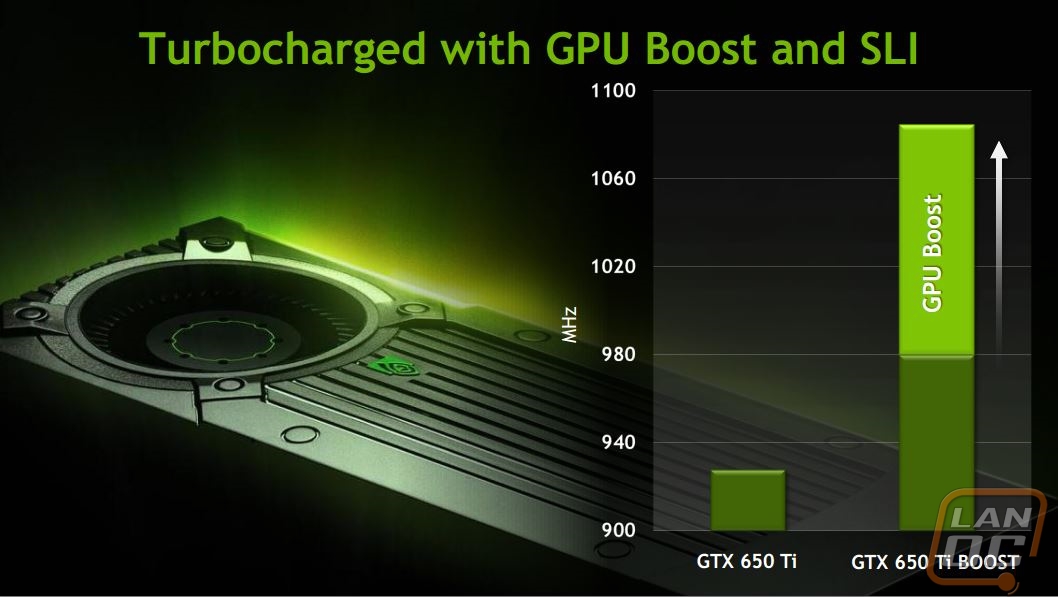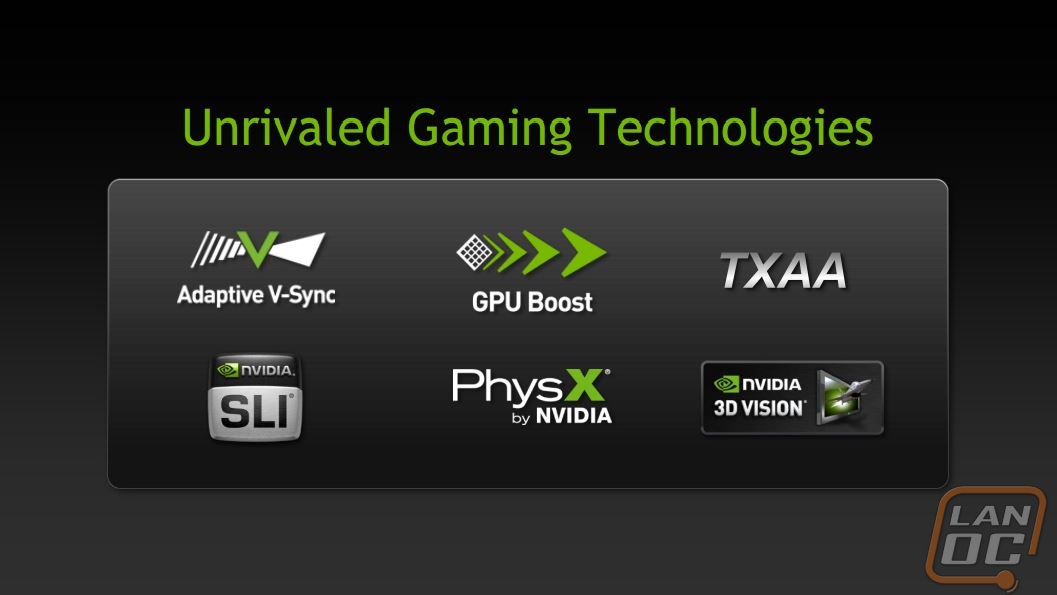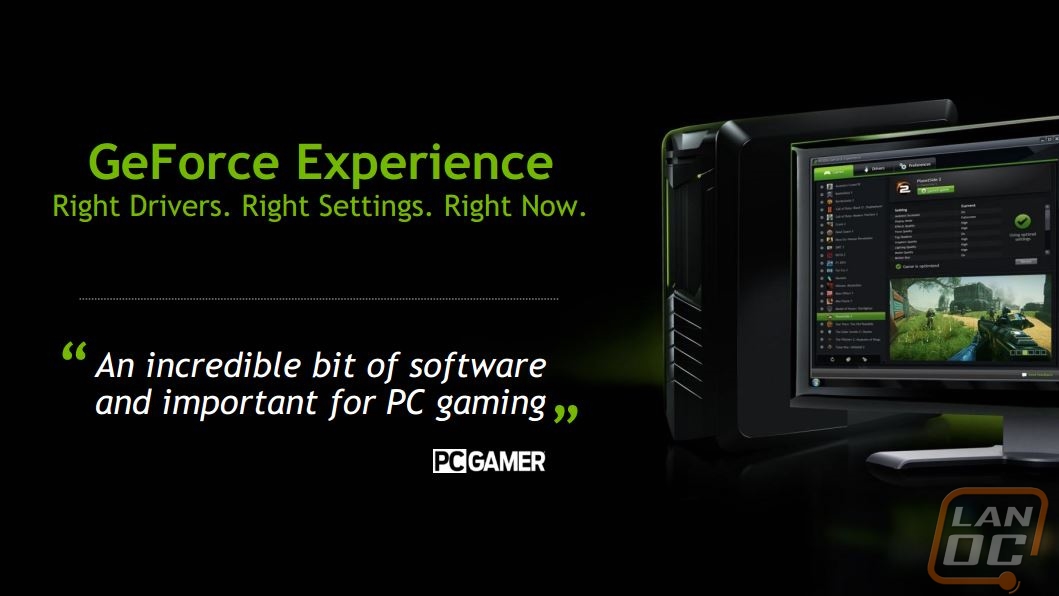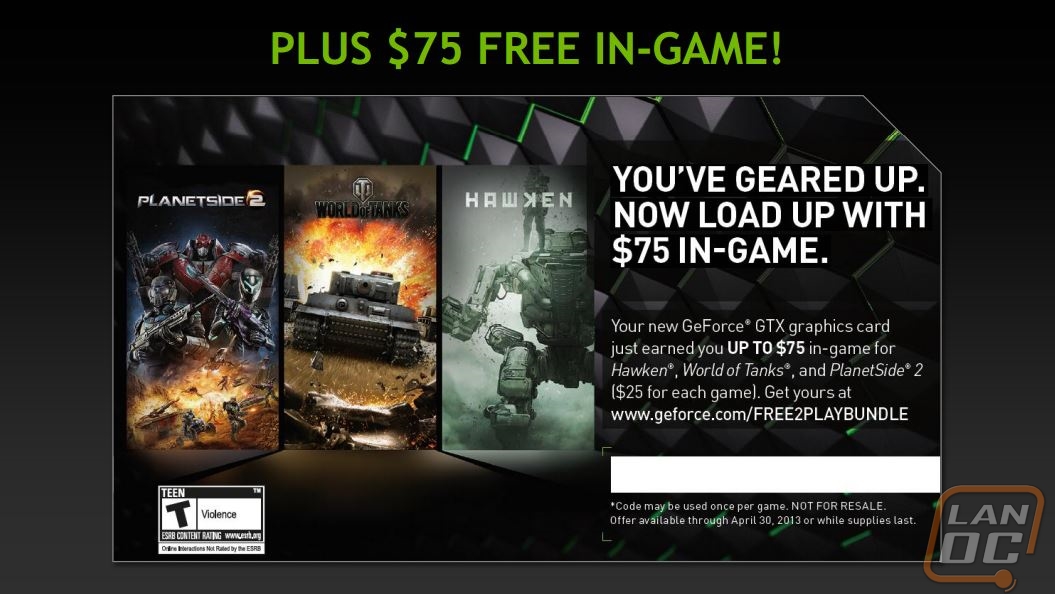 Just a few days over one year ago today Nvidia launched their First Kepler card, the GTX 680. If you asked me then if I would be covering a new Kepler based card (other than a GK110 based card) I doubt I would have believed you. With AMD introducing their HD 7790 this weekend that filled in a gap in their product lineup Nvidia had a response right away with their GTX 650 Ti Boost. The GTX 650 Ti Boost falls between the GTX 650 Ti and the GTX 660, right in the middle of their “Sweet Spot” cards. These are cards that should play any game on the market at 1080p and a price point that most can afford. Let’s look a little closer and see what it is all about.
Just a few days over one year ago today Nvidia launched their First Kepler card, the GTX 680. If you asked me then if I would be covering a new Kepler based card (other than a GK110 based card) I doubt I would have believed you. With AMD introducing their HD 7790 this weekend that filled in a gap in their product lineup Nvidia had a response right away with their GTX 650 Ti Boost. The GTX 650 Ti Boost falls between the GTX 650 Ti and the GTX 660, right in the middle of their “Sweet Spot” cards. These are cards that should play any game on the market at 1080p and a price point that most can afford. Let’s look a little closer and see what it is all about.
Product Name: Nvidia GTX 650 Ti Boost 2GB
Review Sample Provided by: Nvidia
Written by: Wes with help from Adam
Pictures by: Wes
I know what the GTX 650 Ti is, but what does boost stand for
I will be honest, when heard the GTX 650 Ti Boost name I was a little worried. The Boost part does do a good job of explaining what the card is and where it stands in their product lineup. But it is also a little long and complicated for a product name. It reminds me of back when people had to decode GTX, GTS, and GT along with a product number. For those who are confused, this would basically be the GTX 658 while the GTX 650 Ti would be the GTX 655.
I mentioned in the opening that Nvidia is marketing the GTX 650 Ti Boost as a “Sweet Spot” card. It’s important to understand what that really means before we jump into other details. The sweet spot in visual quality is 1920x1080 aka 1080p. Along with that the idea is to be able to run at that resolution at a high setting because being PC gamers, we generally don’t like to turn visual settings down on our games. A sweet spot game should be able to play today’s games at those settings at the cheapest price point possible.
Although the GTX 650 Ti and the GTX 650 Ti Boost share the same number of CUDA cores and very similar names, they are actually very different cards. With the addition of Boost functionality and a jump in base clock speeds the Boost is bound to outperform the GTX 650 Ti. Along with that you are also getting twice the memory (there will also be a 1GB versio of the boost as well) and a 192b memory interface over the GTX 650 Ti’s 128b interface. That gives you an improvement in memory speed from 5.4 Gbps to 6.0 Gbps. On top of it all, they don’t share the same PCB’s or cooling, in fact they are considerably different in size all together. The reason for all of this is actually very simple and obvious when you see the specifications listed out alongside of the GTX 660.
|
Model |
GTX 650 Ti |
GTX 650 Ti Boost |
GTX 660 |
|
CUDA Cores |
768 |
768 |
960 |
|
Base Clock |
925 Mhz |
980 MHz |
980 MHz |
|
Boost Clock |
N/A |
1033 MHz |
1033 MHz |
|
Memory Config |
1GB / 128b GDDR5 |
2GB / 192b GDDR5 |
2GB / 192b GDDR5 |
|
Memory Speed |
5.4 Gbps |
6.0 Gbps |
6.0 Gbps |
|
Power Connectors |
6-pin |
6-pin |
6-pin |
|
TDP |
110W |
134W |
140W |
|
Outputs |
2x DL-DVI Mini HDMI |
2x DL-DVI HDMI Displayport 1.2 |
2x DL-DVI HDMI Displayport 1.2 |
|
Bus Interface |
PCI Express 3.0 |
PCI Express 3.0 |
PCI Express 3.0 |
|
SLI |
No |
2-way SLI |
2-way SLI |
As you can see, the GTX 650 Ti Boost actually shares most of its details with the GTX 660. The reduced CUDA core GPU of the GTX 650 Ti in the GTX 660 package is a good thing though. Not only do you get GPU Boost and memory improvements, but you also get an SLI connection, something that the GTX 650 Ti didn’t have. I think this is especially important at a lower price point. This allows someone who only has enough money for a GTX 650 Ti Boost an upgrade path for next year as games improve and require more power. This way they don’t have to sell their card to upgrade.
|
Processing Units |
|
|
Graphics Processing Clusters |
2 or 3 |
|
SMXs |
4 |
|
CUDA Cores |
768 |
|
Texture Units |
64 |
|
ROP Units |
24 |
|
Clock Speeds |
|
|
Base Clock |
980 MHz |
|
Boost Clock |
1033 MHz |
|
Memory Clock (Data rate) |
6008 MHz |
|
L2 Cache Size |
384KB |
|
Memory |
|
|
Total Video Memory |
2048MB GDDR5 |
|
Memory Interface |
192-bit |
|
Total Memory Bandwidth |
144.2 GB/s |
|
Texture Filtering Rate (Bilinear) |
62.7 GigaTexels/sec |
|
Physical & Thermal |
|
|
Fabrication Process |
28 nm |
|
Transistor Count |
2.54 Billion |
|
Connectors |
2 x Dual-Link DVI 1 x HDMI 1 x DisplayPort |
|
Form Factor |
Dual Slot |
|
Power Connectors |
1 x 6-pin |
|
Recommended Power Supply |
450 Watts |
|
Thermal Design Power (TDP) |
134 Watts |
|
Thermal Threshold |
98° C |
There are a few other features of the GTX 650 Ti Boost that I would like to bring up quickly as well. We have covered them in the past as well, but they do carry over. Along with GPU Boost and SLI, the card supports Adaptive V-Sync, TXAA, PhysX, and 3D Vision. Here are short breakdowns.
Adaptive V-Sync
Adaptive V-Sync is an Nvidia technology that allows a little more fluidity when running V-Sync. With standard V-Sync you will normally run at a solid 60 FPS as long as your video card can handle it. When it can’t it will halve itself until it can run it. That means if your card can run 59 FPS it’s going to drop down to 30 until the card can do 60 FPS. Adaptive V-Sync basically turns off V-Sync in those situations then turns it back on once you are back up to 60 FPS.
TXAA
TXAA is a recently introduced approach to reducing Aliasing, AKA smoother lines. Typical Anti-Aliasing is very demanding. TXAA gives similar results but is less demanding, for example TXAA 2x will give you results similar to 8xMSAA but at a performance similar to 2xMSAA.
PhysX
Anyone who has played Borderlands 2 on an Nvidia video card knows what Physx can do. This is Nvidia’s physics simulation done via the video card. Without it you are stuck handling physics processing on your CPU, meaning most will be turned off. PhysX brings added realism to games with dynamic destruction, particle based fluids, and life-like animation.
3D Vision
3D Vision is Nvidia’s shutter glasses based 3D technology that gives you a 3D gaming experience when used with a supported monitor and their glasses. It’s obviously not for everyone, but for people who are looking for an even more realistic experience from their games there isn’t anything that compares to it.
On top of all of those features there is one other Nvidia feature I want to point out, it was even mentioned on our forums yesterday in relation to Nvidia’s latest driver update. The GeForce Experience is what Nvidia calls their new application that updates your drivers automatically as well as optimizes your game settings based on your hardware configuration. For someone who wants a hands off gaming experience you couldn’t ask for a better application.
Last but far from least the GTX 650 Ti Boost will also be included in Nvidia’s free play bundle that gives you up to $75 in in game currency in Hawken, World of Tanks, and PlanetSide 2 ($25 for each game). While they may not be giving away specific game, free money is still free money even if it is in the form of in game currency. This way you can still game with your friends in free to play games but this time with a better tank for example.
Card Layout and Pictures
As per the norm with reference cards, our GTX 650 Ti Boost came in wrapped up in a static protective bag, no special packaging.

The fan shroud on the GTX 650 Ti Boost may look familiar, that is because this is the exact same one as the GTX 660 as I mentioned in our breakdown of the cards features. For a reference design it is very stylish. They have tried to bring the same styling from the GTX 690 and Titan cards have into their sweet spot cards. In a way I like the styling but I did prefer the cleaner look of the GTX 680 itself. As for cooling, this is a sealed design for the most part meaning it will pull air in from inside of the case and blow it out of the back PCI slots. This is much better than video cards that blow hot air into your case. Sure they will keep the card cool but they will also warm up everything else in your case as well.



The fan on the GTX 650 Ti Boost is gigantic. Due to the shorter PCB of the card, Nvidia was able to extend the fan shroud out and pack in a larger fan that pushes a considerable amount of air across the card to keep things cool.

Around back you can see what I was talking about with how they were able to fit such a large fan. The GTX 650 Ti Boost’s PCB is short but the fan shroud extends past to make it a normal length card. This is still considerably larger than the reference design of the GTX 650 Ti though, it was the only card that my wife has called “cute” due to its small size. Also out back you will notice the black PCB, hopefully we see most of the venders continue with this as it does look better in most situations over green and blue.

For a power connection, just like the GTX 670 and GTX 660 the power is down at the end of the PCB in the middle of the card. For power you only need one six pin connection to push the cards 134 watt TDP. On the fan shroud they did leave a little extra room for ease of getting as the plug as well.

Unlike its non-boosted brother, the GTX 650 Ti Boost also has an SLI connection available for future expansion.

The PCI slot is packed full of connections. You have two DVI connections (one dual link and one single) an HDMI port, and a display port connection as well. The HDMI and Display port connections are both full sized meaning they won’t require weird adapters or special cables that are harder to come by. I would personally like to see two HDMI ports rather than an HDMI and then a Display Port. This would make setting up a 3+1 setup much easier in the future.


Our Test Rig
Asus Rampage IV X79 Motherboard
Seagate Constellation 2tb Hard drive
Cooler Master Gold Series 1200 Watt PSU
http://www.highspeedpc.com/ Test Bench
Kingston 1600Mhz DDR3 Quad Channel Ram
Kingston Hyper X 120 SSD
Our Testing Procedures
Batman Arkham Asylum (built-in benchmark; 1920 x 1080; Multi Sample AA 16XQ; Detail Level: Very High; Bloom: Yes; Dynamic Shadows: Yes; Motion Blur: Yes; Distortion: Yes; Fog Volumes: Yes; Spherical Harmonic Lighting: Yes; Ambient Occlusion: Yes; PhysX: Off)
F1 2011 (built-in benchmark; 1920 x 1080; Multi Sample AA 4x; Vsync: Off; DirectX: 11; Shadows: Ultra; Particles: High; Crowd: High; Drivers: Ultra; Distant Vehicles: Ultra; Objects: Ultra; Trees: Ultra; Vehicle Reflections: Ultra; Post Process: Ultra; Skidmarks: On; Cloth: High)
Super Street Fighter Arcade Edition (built-in benchmark; 1920 x 1080; Multi Sample AA: C16xQ; Vsync: Off;Filtering: 16x; Model Quality: High; Stage Quality: High; Soft Shadow: Extreme; Self Shadow: High; Motion Blur: High; Particles: High; Extra Effect: Off)
Dirt 3 (192x1080 - 4xMSAA - high settings, in-game benchmark)
Metro 2033 DX11 (built-in benchmark, 1920 x 1080; DirectX: DirectX 11; Quality: Very High; Antialiasing: MSAA 4X; Texture filtering: AF 4X; Advanced PhysX: Enabled; Tessellation: Enabled; DOF: Disabled)
Metro 2033 DX10 (built-in benchmark, 1920 x 1080; DirectX: DirectX 10; Quality: Very High; Antialiasing: MSAA 4X; Texture filtering: AF 4X; Advanced PhysX: Enabled; Tessellation: Enabled; DOF: Disabled)
Total War: Shogun 2 Direct X11 Benchmark High setting
Crysis 2 Using Adrenaline Crysis 2 benchmark two runs. The first set of runs set to ultra-settings, 1080p, 4x Anti-Aliasing, DX11, Laplace Edge Detection Edge AA, on the Times Square map, with hi res textures turned on. The second benchmark set to Xtreme at 1080p, no AA, DX9, Edge Blur, Hi-Res Textures turned off on the Times Square Map.
Battlefield 3 Using Fraps with the game set to Ultra settings with 4x MSAA Antialiasing Deferred, 16X Anisotropic Filter, at 1920x1080.
Sniper V2 Elite 1920 x 1080 resolution, graphics detail set to ultra
Dirt Showdown 1920 x 1080 resolution, 4x MSAA multisampling, vsync off, Shadows: ultra; Post Process: High; Night Lighting: High; Vehicle Reflections: Ultra; Ambient Occlusion: Ultra; Water: high; Objects: Ultra; Trees: Ultra; Crowd: Ultra; Ground Cover: High.
Synthetic Benchmarks For video cards our synthetic benchmarks are limited to 3DMark Vantage, 3DMark Vantage 2011, and 3DMark 2013 (AKA 3DMark). 3DMark Vantage is run with PPU turned off with results from both the performance and high settings. In 3DMark Vantage 2011 we run both performance and extreme benchmarks. The same goes for the most current version of 3DMark, we run through Fire Strike on standard and extreme settings.
Unreal Heaven Benchmark DX11 (API: DirectX11; Tessellation: Disabled; Shaders: High; Anisotropy: Off; Stereo 3D: Disabled; Multi Monitor: Unchecked; Anti-aliasing: 8x; Full Screen: Checked; Resolution: 1920 x 1080)
Unreal Heaven Benchmark DX11 heat testing We run through Unreal Heaven at 1080p for 30 minutes to test in game heat performance and noise output of the card while under load.
FurMark We use Furmark to push the video card to the limit and test its cooling performance. Keep in mind that FurMark pushes cards well beyond what they would ever do in game. Our tests are done using the built in 1080p benchmark. All testing is done with a room temperature of 70 degrees.
Cooling and Noise
For cooling testing we are moving away from Furmark testing to a better representation of what to expect in game. Furmark puts such a load on cards that they are now designed to decrease performance to prevent damage. We did include it Furmark this time around, just for comparison though.
Our in game temperatures from the GTX 650 Ti Boost came in higher than Furmark. This is a good example of a card normally pulling power, but in this case in game it actually was boosting to get the highest performance possible. At 75 degree’s it was still very close to the HD7870 that we tested last week and it had an aftermarket cooler, not too bad for a reference design.
As the GTX 650 Ti Boost heated up, the fan did spin up and make a noticeable amount of noise. I wouldn’t consider it an issue at all, but it was noticeably louder than the GTX 650 Ti for example.

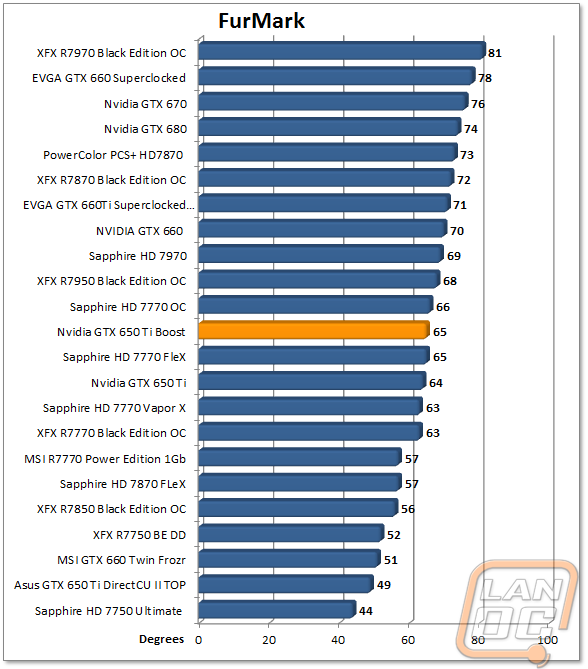
3DMark
We know where the Boost falls theoretically; let's take a closer look at the numbers. Marketwise, the Ti Boost is almost literally priced at the median of the GTX 650 Ti and the GTX 660 (based off the 2GB sample we were provided). Our synthetic and in-game testing results tell a very similar tale. 3DMark 11 shows about a 1000 point gain over the 650 Ti and 1000 lag under the GTX 660 in Performance mode and 400 points in the same manner in Extreme mode. Vantage follows suit, approximately 3000 points in between Ti and the 660 using High settings and 5000 points in Performance. Frames per second in game testing discrepancies are little more varied, but typically show a gain of 10 to 15 frames over the Ti and around 10 frames under the 660.
How does the GTX 650 Ti Boost stand up to the competition? Unfortunately, we're still waiting on our sample of the AMD 7790 (we'll cover benchmarks comparisons between the Boost in that article), but the 7850 and 7770 are still good comparisons. The GTX 650 Ti Boost comes in well above the 7770 all of our 3Dmark testing, while our sample of the XFX 7850 Black Edition OC came in just a little above the Boost.


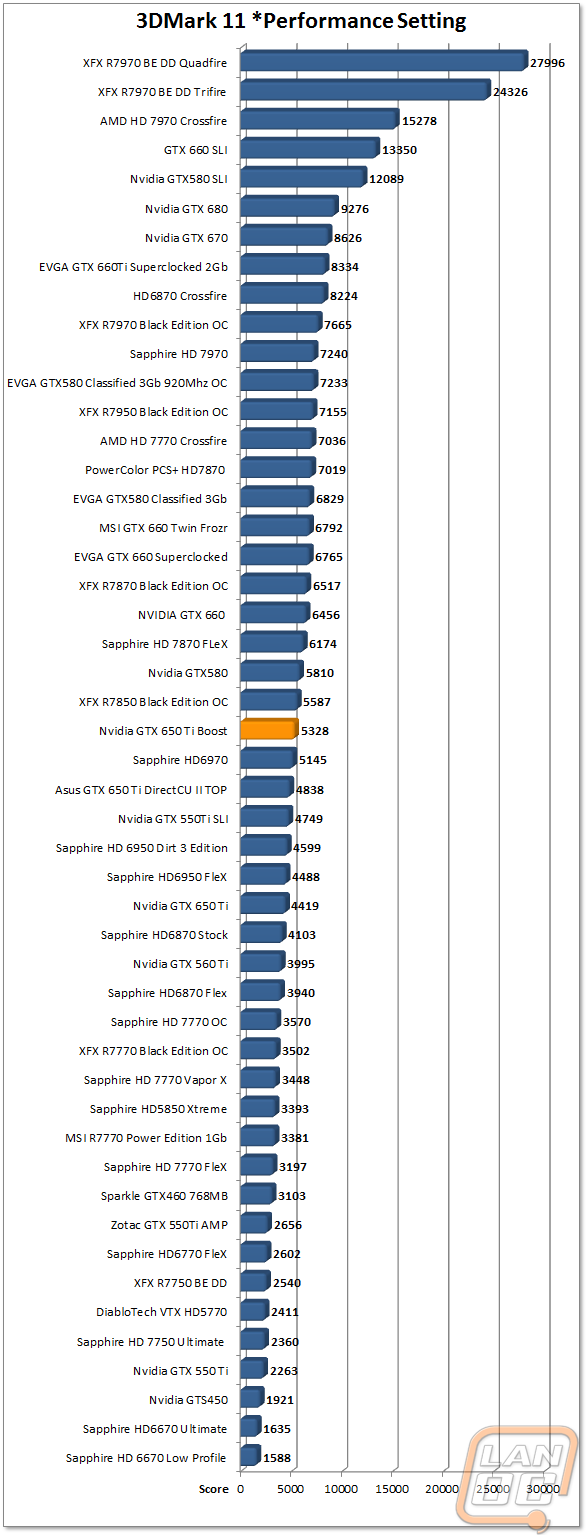
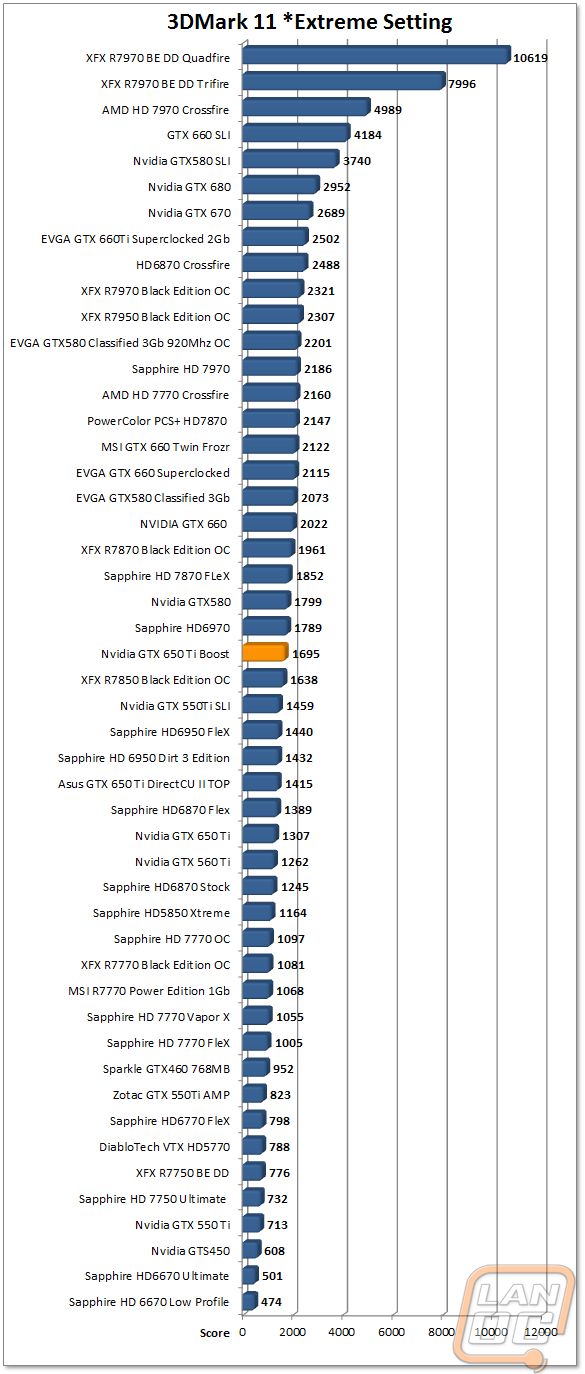

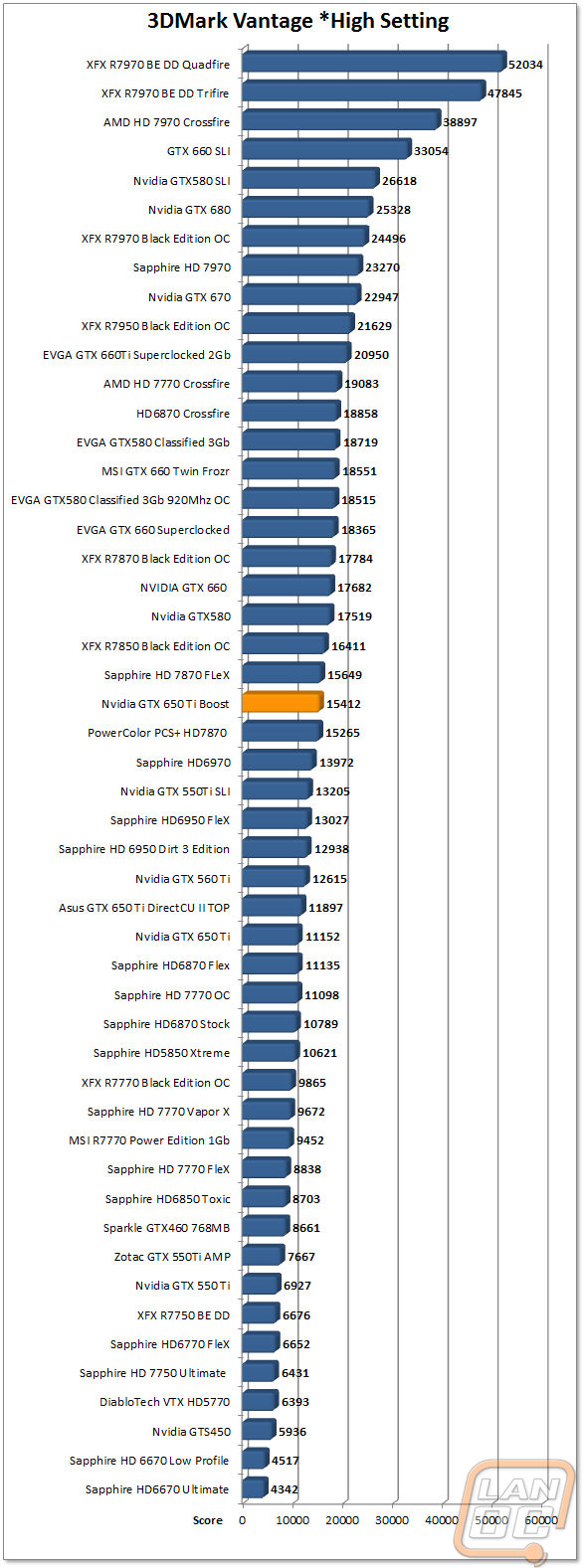
In Game Performance
Our in game testing of the GTX 650 Ti Boost is very interesting. In most cases the GTX 650 Ti Boost came in on par and sometimes ahead of the HD 7850 OC’ed card. In some cases like Dirt 3, Crysis 2 DX9, and the Unreal Heaven benchmark it actually outperformed the HD 7870 that we tested just this last week. That is impressive considering its competition should be the HD 7790. Nvidia’s original claim of it playing every game on the market could very well be true, but if you consider 60 FPS to be the standard, then games like Battlefield 3, Crysis 2, Shogun 2, and Sniper Elite v2 fall a little short. Having said that, the in game performance is still very impressive and I wouldn’t think twice when putting one into a computer for anyone who wants great performance on a budget.
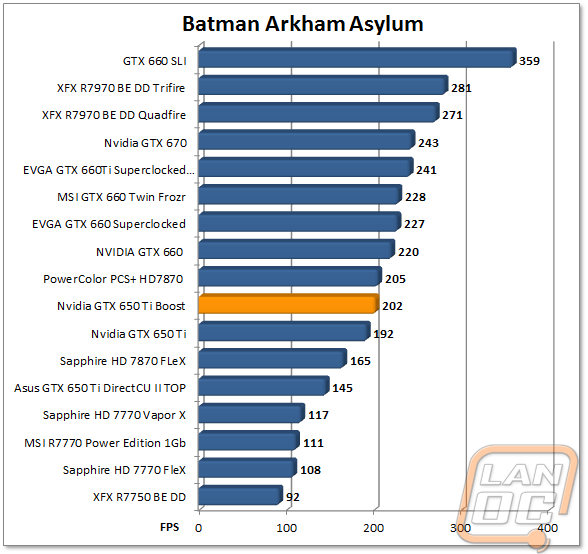
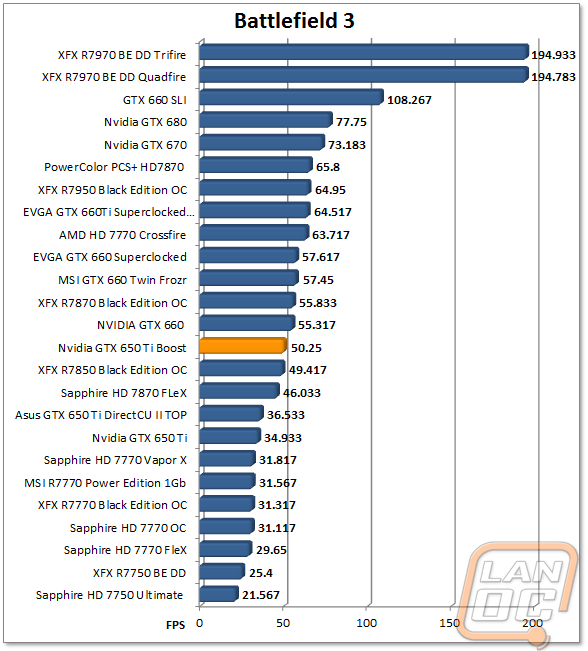
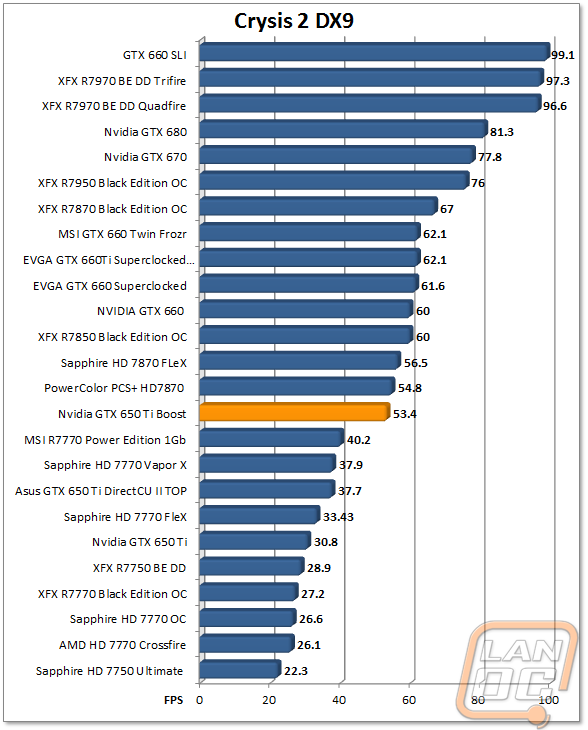
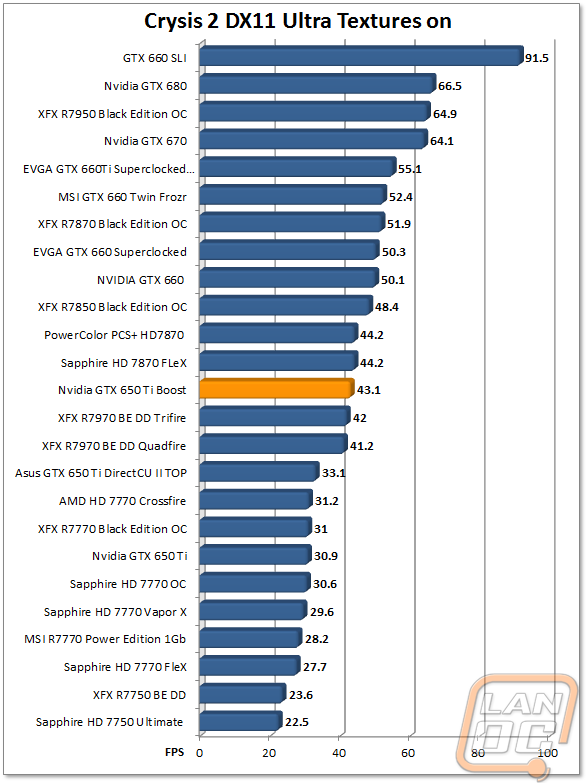
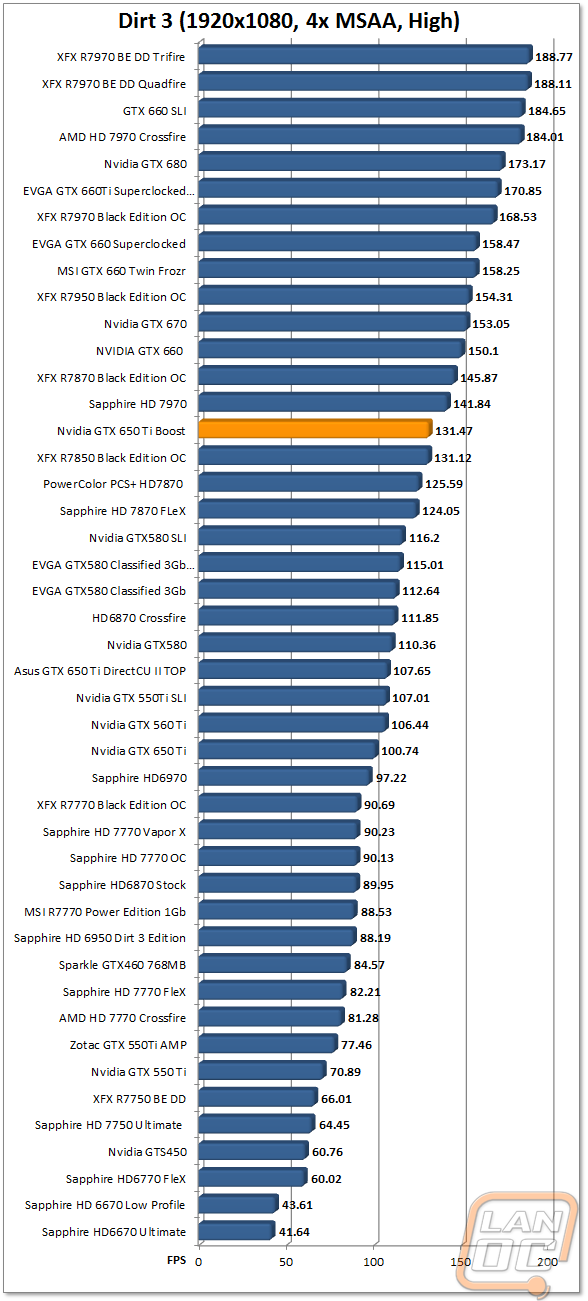
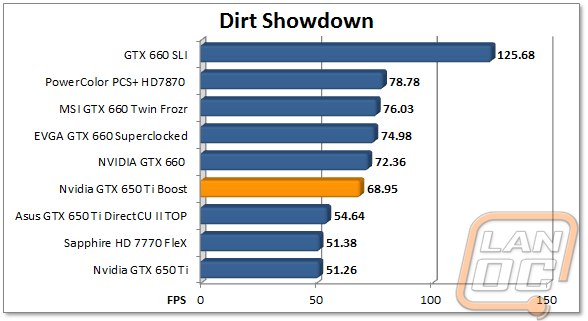
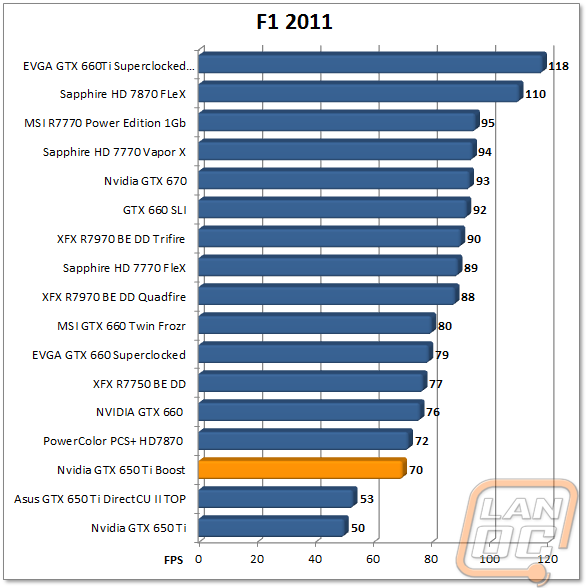
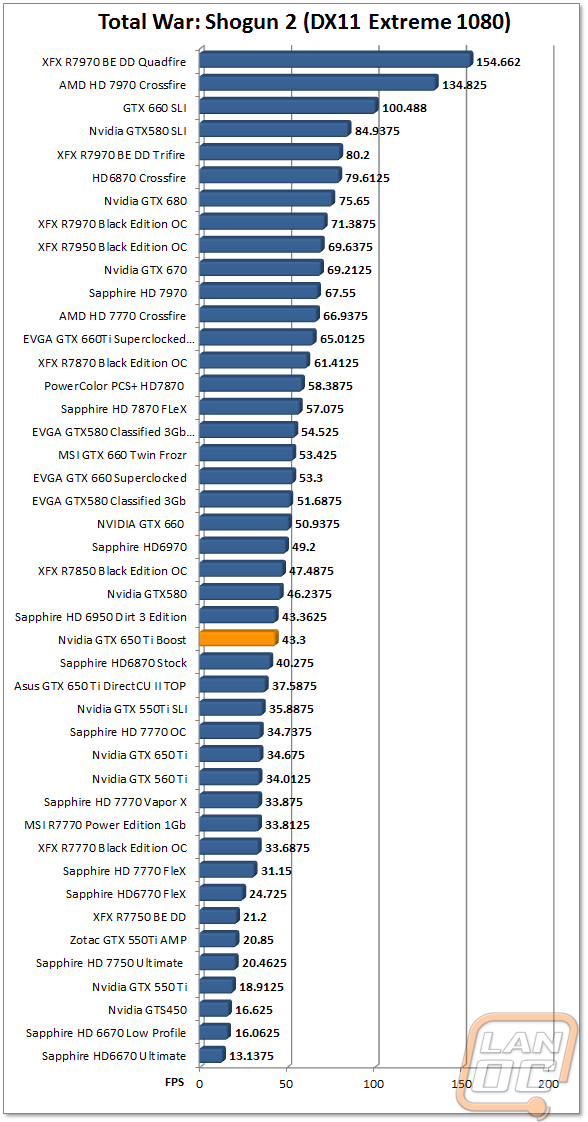
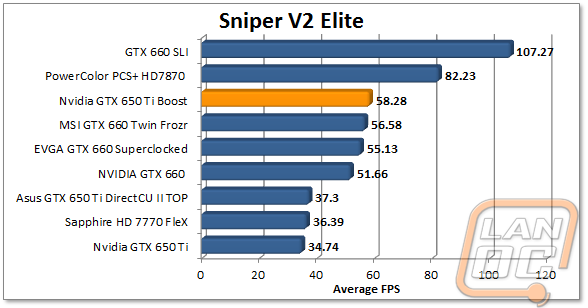
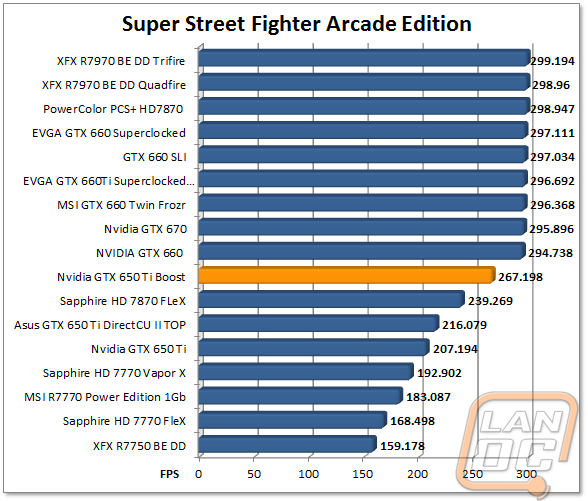
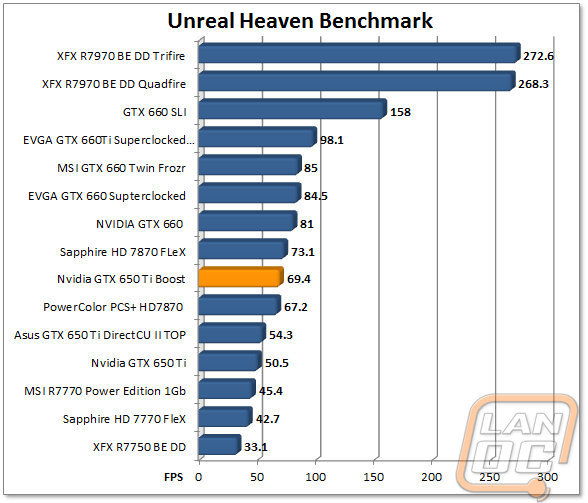
Overall and Final Verdict

In the ever changing video card market, the perfect card to suggest for a person on a budget is always changing. Before we jump into the details on the GTX 650 Ti Boost, I should point out that along with the launch of this card Nvidia is moving their price points around as well. Here is the Suggested price points as of this morning on their mid-range cards including the GTX 650 Ti Boost 2GB card that we tested today, and the 1 GB version that will be shipping soon as well.
· $109 - GeForce GTX 650
· $129 - GeForce GTX 650 Ti
· $149 - GeForce GTX 650 Ti BOOST 1GB
· $169 - GeForce GTX 650 Ti BOOST 2GB
· $199 - GeForce GTX 660
Anyone on the market for a video card right now should be very excited as this announcement as every card listed there is a good deal. As for the GTX 650 Ti Boost 2GB. I was extremely impressed with its performance, in game especially. This really is a sweet spot card that allows you to play anything at good settings and at 1920x1080. Really the only downsides I came across were in our cooling testing with it running warmer than I had hoped in our new cooling test. This included a little more noise that I would have hoped for. Beyond that my only complaint was with the name of the card itself being a little long with the Ti and Boost on it, frankly a very petty complaint. Its performance and a price point that is within almost everyone’s budget make up for its issues. At $169, the 2GB model is priced a little high against the HD 7790, but with a 1GB model soon to be available as well they will have a card to compete with it directly.
I spoke before about the in game currency that also comes with the card. If this is very important to you, it would still be a better deal to go with the slightly faster GTX 660 due to it coming with $150 vs. the $75 you get with the GTX 650 Ti Boost. But for most, the credits are really just a bonus. The card itself holds its own at its price point without any additional add-on’s.



